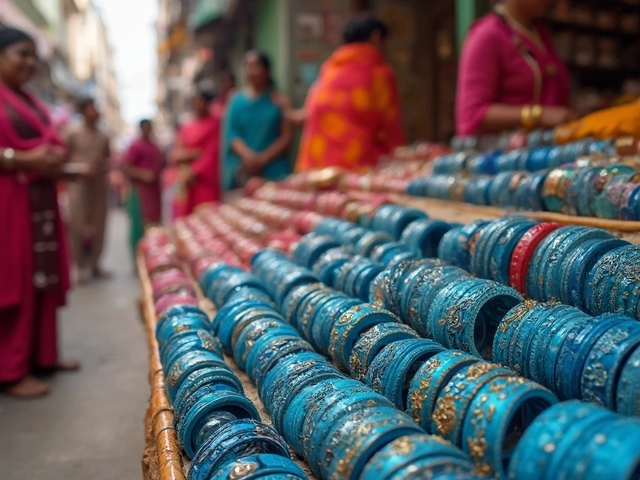The hunt for cheap gold jewellery can feel like a wild goose chase, especially if you want authentic temple designs. Everyone’s looking for the same thing: lower prices without getting ripped off with fake stuff or poor quality. But here’s the twist—India doesn’t really have one single “cheapest” gold brand. Why? Gold price rates are pretty much the same across the country on any day, so it’s actually making charges, designs, and brand margins that make one brand cheaper than another.
For temple jewellery, those big South Indian chains—Kalyan Jewellers, Malabar Gold, Jos Alukkas—are everywhere. Sure, they’re reliable, but their making charges can go from 8% up to even 25% for intricate temple pieces. Local jewellers? They sometimes go as low as 3-5% if you bargain hard and pay cash. Not all local shops are shady—some are family businesses with a reputation to protect. The catch is you need to know what purity certificate to ask for. More on that coming up.
- What Makes Gold Jewellery Expensive in India?
- Cheapest Gold Brands: Big Names vs Local Jewellers
- Saving Money: Tips When Shopping Temple Jewellery
- How to Check Purity and Avoid Getting Cheated
What Makes Gold Jewellery Expensive in India?
Ever wonder why that temple jewellery looked way cheaper in one shop and nearly double somewhere else? Spoiler: it’s not just about the gold price itself. In India, the main factors playing with the final bill are making charges, taxes, the weight and purity of gold, and brand reputation.
Let’s break it down:
- Gold Rate Per Gram: The daily gold rate is set by international market prices. Every shop in your city will show the same rate on that day for 22kt or 24kt gold. But the store’s charges get slapped on top of this.
- Making Charges: This is a big one. Making charges pay for the work needed to turn raw gold into jewellery. For temple jewellery, which needs careful handwork, these charges can be steep—anywhere from 8% to even 25% of the gold value. Local jewellers might go lower, sometimes just 3-5%.
- Purity & Hallmarking: 22kt and 24kt are common, but temple jewellery is usually 22kt. Always check for BIS hallmark certified purity—you don’t want to pay for more pure gold than you’re getting.
- GST: On top of everything, you pay 3% Goods and Services Tax on gold jewellery since 2017. It can’t be avoided, no matter where you buy.
- Brand Premium: Big brands charge a little extra because of their name, in-house warranties, and fancy showrooms. That’s basically the 'comfort' charge for peace of mind, but it makes things pricier.
| Cost Component | Range/Details |
|---|---|
| Gold Price (per gram, June 2025) | Approx ₹6,600 (22kt), ₹7,200 (24kt) |
| Making Charges | 3%-25% (lower at local shops, higher at brands) |
| GST | 3% on entire bill |
| BIS Hallmarking Charge | Usually ₹35-₹45 per item |
| Brand Premium | 0%-10% (for big names) |
So the next time you see a big price tag on temple jewellery, look beyond the gold rate. It’s those extra add-ons that send the price climbing. The best way to avoid nasty surprises? Always ask for a breakdown of all the charges before you pull out your wallet.
Cheapest Gold Brands: Big Names vs Local Jewellers
When you walk into a big chain like Malabar Gold or Kalyan Jewellers, things feel safe and familiar. These stores are known for proper bills, certified gold, and lots of designs. But there’s a trade-off: the making charges on temple jewellery are usually much higher. You'll often see 10% or more tacked onto the gold price for even simple pieces, and it can go above 20% for heavy temple necklaces or jadau work. The chains also charge GST, which adds 3% more to the final bill. The upside? You've got better resale value, clear purity stamps, and peace of mind about fakes.
Now, let’s talk about the local guys. In places like Chennai’s T. Nagar, Bangalore’s Commercial Street, or Kerala’s Thrissur, you’ll find small shops selling temple jewellery India buyers swear by. These jewellers often set their making charges between 3% and 7%. If you know how to negotiate or are a regular customer, you might get a better deal. They sometimes skip GST if you pay in cash, but that’s not exactly above board. Quality can be a mixed bag, so always ask for a BIS hallmark, which is your proof the jewellery is real gold.
Got a family jeweller? Even better. They’ll usually make custom pieces for less than what you’d pay in a branded showroom. The only catch is, you have to be careful about measuring purity. Don't be shy about asking them to weigh the piece and show you the stamp right in front of you.
The real savings come when you shop in gold hubs like Coimbatore or Kolkata. These cities supply a lot of the gold to the rest of the country. The choice is huge, and competition keeps prices and making charges down. If you ever go temple-hopping around South India, those small jewellery shops near the temples often have the most genuine styles—just double-check for hallmarks and receipts.
- Big brands: reliable but pricier, always certified, and resale value is strong.
- Local jewellers: cheaper if you know what to look for, but you need to be careful with purity.
- Gold markets in certain cities often have both low prices and authentic temple designs.

Saving Money: Tips When Shopping Temple Jewellery
Everyone wants that stunning, classic temple jewellery look without blowing up their bank balance. Here’s the deal—saving money isn’t just about finding the lowest shop price. It’s about being street-smart at every step, from picking brands to checking jewellery bills.
The first thing to watch? Cheapest gold brand isn’t always the one with the lowest gold rate. It’s often about the making charges. Big brands toss in design charges, wastage, and sometimes even a brand premium. For example, Malabar Gold can charge a 12-15% making charge on a basic Lakshmi pendant, while a small Chennai jeweller might only add 5-7%. That’s a big gap, especially on large purchases!
Another tip: Don’t just look at online prices. Temple jewellery is heavy on design, so even a slight difference in weight or finishing can mean paying thousands more. If you’re going for brands, scan their festive-time deals—they often drop making charges by up to 50% during Akshaya Tritiya or Diwali. Jos Alukkas started ‘zero making charge’ days last year on select pieces and people lined up outside!
Now, if you’re buying from your trusted local shop, always demand a BIS Hallmark certificate. No Hallmark? Walk away. Hidden charges in small print are real, so read that bill twice. Ask for detailed billing—each charge for gold weight, making, and GST listed separately. A lot of folks don’t realize some jewellers hike the net weight by a gram or two or tuck ‘wastage charges’ in.
Here’s my favourite trick: If your family has old gold jewellery you never wear, most jewellers let you exchange it at close to market value. It’s a solid way to cut your cash outflow. Even the top brands offer ‘old gold exchange’ schemes, but check if they charge extra for melting or testing. Last year, Kalyan Jewellers paid my wife, Anjali, 97% of gold’s value during a festival offer, with no melting deductions. Not bad, right?
"When you buy gold jewellery, the best deal is a low making charge, clear purity marking, and an itemized bill—you want all three together, not just one," says Shreyas Iyer, gold analyst at Bullion Times.
Smart shopping boils down to comparing. Here’s a table with typical charges (as of April 2025) for some popular options:
| Brand/Shop | Making Charges | BIS Hallmark |
|---|---|---|
| Kalyan Jewellers | 8-25% | Yes |
| Malabar Gold | 10-18% | Yes |
| Jos Alukkas | 8-20% | Yes |
| Local Shop (reputed) | 3-8% | Mostly—Ask! |
Let’s sum up with a quick checklist when you’re on a gold hunt:
- Always check and compare making charges—don’t skip the small print.
- Buy during deals and festive offers for lower charges.
- Insist on BIS Hallmark even at tiny local shops.
- Use old gold as exchange if you have it—the savings can be huge.
- Demand detailed, itemized bills. If anything feels fishy, walk out.
Stick to these, and you’ll end up with truly budget-friendly, beautiful temple jewellery—and zero regrets.
How to Check Purity and Avoid Getting Cheated
So you’ve found a beautiful piece of temple jewellery at a price that sounds too good to be true. Here’s where you need to watch out, because checking gold purity isn’t something you can skip. Even big shops slip up, and local stores sometimes depend on trust more than test results. If you want to get your money’s worth, there’s no shortcut—always ask to see proof before buying.
In India, BIS (Bureau of Indian Standards) hallmarking is your safety net. From June 2021, it’s actually mandatory for most gold jewellery sold to be hallmarked. What you’re looking for is a tiny stamp or laser mark with these four details:
- BIS hallmark logo
- Purity in Karat and fineness (for example: 22K916 means 91.6% purity)
- Assaying centre’s mark/number
- Jeweller’s identification mark or code
If the piece doesn’t have this, even if the salesman swears by it—walk away. For quick comparison, here’s what you need to spot for popular types of gold used in temple jewellery india:
| Gold Type | BIS Hallmark Code | Purity (%) | Common Use |
|---|---|---|---|
| 22K | 916 | 91.6% | Necklaces, bangles, heavy jewellery |
| 18K | 750 | 75.0% | Detailed work, lightweight pieces |
| 14K | 585 | 58.5% | Budget-friendly pieces |
Pro-tip: Don’t forget to ask for a bill with breakdown of gold rate, weight, purity, making charges, and GST. No bill? If anything goes wrong, there’s zero chance of getting your money back or exchanging it. Don’t fall for emotional stories or hurry by the seller—take your time to see all marks.
Finally, if you get something inherited or gifted and want to check purity, any trusted jeweller with a carat meter can test it. Some places even let you witness the test on the spot for a small fee. Don’t just rely on what’s shiny—be the person who checks every detail, so your temple jewellery is worth its weight in gold, not in regret.



